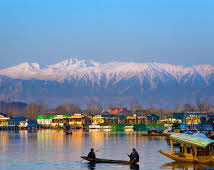
Srinagar district is situated in the centre of Kashmir Valley, is surrounded by five districts.In the north it is flanked by Kargil,in the South by Pulwama,in the north-west by Budgam.
The capital city of Srinagar,is located 1730 metres above sea level.The district with a population of around 9,00,000 souls(1991- census), is sperad over an area of 2228 Sq.Kms.
It comprises three tehsils/ towns viz Srinagar, Ganderbal and Kangan, four blocks (Srinagar, Ganderbal, Kangan and Leh), besides 175 villages.The population density in the district Srinagar is 401 per Square Kilometer which is highest in the state. The literacy rate of the district was 33.80%in 1981.
According to a popular legend which is mentioned in Kalhana's Rajtaringini Kashmir valley was a vast lake. Kashyap Rishi drained out the water and made it habitable.
It is said that originally Yakshas, and Pisacas tribes inhabited the valley at the higher reaches and did not allow the inhabitants of the valley to live in peace. King Ashok brought Budhism to Kashmir which was strenthened by Kanishka.
In 6th century Huns came to rule the valley and Mihirkul was one of the infamous Hun ruler. The area attained freedom in 530 AD which was shortlived.
According to Sir Aurel Stein the famous interpretor of Kalhana the chronicler of Kashmir the city of Srinagar had big market and mansions made of wood touching the clouds. Hieun-tsang the famous Chinese traveller visited Srinagar and has described it his memoirs.
Various capitals were established by the latter kings but ultimately the city of Srinagar was destined to be the capital of the State. These capitals are now found only in ruins or history.
Some of the famous capitals are Prvaerpora of Praversen, Prihaspora of Lalitaditya, Jayapida's Jayapora, Avantivarman's Avantipur and cities of Kanishkapura and Juskapura.
During muslim rule Sultan Sadar-ud-din founded Rinchenpur and Ala-ud-din founded Alauddinpura near Hariparbat Hill. ZainulAbideen founded Nowshera as the capital while Akbar founded Naagar Nagar and raised 28ft tall wall around it.
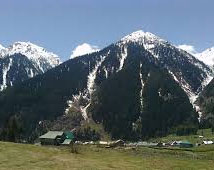
Aru
The chirrup of birds, the gentle swish of the breeze, the sapphire coloured sky, and all at 2408m above sea level - this is Aru. Far far away from the routine urban life, Aru is a meadow bordered on one side by a ravine of the Lidder River. A little stream also flows past in the green-gold grass.
Avantipur
Situated at the foot of one of the spurs of the mountain Wastarwan, this temple site overlooks the Jhelum, which wends its tortuous way gently by the side of the Jammu-Srinagar highway.
Dal Lake
Dal Lake is, initially, one of the most confusing parts of Srinagar for it's not really one lake at all, but three. Further more much of it is hardly what one would expect a lake to be like - it's a maze of intricate waterways and channels, floating islands of vegetation, houseboats that look so firmly moored they could almost be islands and hotels on islands which look like they could simply float away.
Hari Parbat Fort
The 18th century fort tops the Sharika Hill, which is clearly visible, rising to the west of Dal Lake. The fort was constructed by Atta Mohammed Khan from 1776 but the surrounding wall is much older, it was built between 1592 and 1598 during the rule of Akbar.
Hazratbal Mosque
The most important Muslim shrine of Kashmir, that commands the reverence of the people beyond measure, is undoubtedly the Hazratbal Shrine, which is situated on the left bank of the famous Dal Lake in Srinagar. This unmatched reverence is anchored in the love and respect for the Prophet.
Mughal Gardens
Set some distance back from the lake, but reached by a small canal, the Shalimar were built by Emperor Jehangir for his wife Nur Jahan, 'light of the world' in 1616. The Nishat Bagh is another lovely garden with its 12 terraces representing the 12 signs of the zodiac, which descend gradually and seem to almost merge into the lake. Smallest of the Srinagar Mughal gardens, measuring just 108 metres by 38 metres, the Chasma Shahi, or 'Royal Spring', are well up the hillside, above the Nehru Memorial Park.
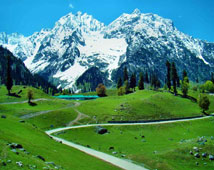
Nagin Lake
Known as the 'Jewel In The Ring', Nagin is generally held to be the most beautiful of the Dal lakes. Its name comes from the many trees, which encircle the small, deep blue lake. Nagin is only separated from the Larer Dal lakes by a narrow causeway and it also has a number of houseboats moored around its perimeter.
Shankaracharya Hill
Rising up behind the boulevard, beside Dal Lake, the hill was once known as Takht-i-Sulaiman, the throne of Solomon. The philosopher Shankaracharya stayed at this place when he visited Kashmir ten centuries ago to revive "Sanatan Dharma".
Jama Masjid
one of the most important mosque is an impressive wooden structure, notable
for the more than 300 soaring pillars supporting the roof; each made of
a single deodar tree trunk. The main gate is to the south and the outer
cloisters surround a spacious, green and peaceful inner courtyard.
Pari Mahal
The old Sufi college of Pari Mahal, the 'palace of the fairies', is only a short distance above the Chasma Shahi gardens. One can easily walk from the gardens up to the Pari Mahal then follow a footpath directly down the hill to the road that runs by the Oberoi Palace Hotel. The Pari Mahal consists of a series of arched terraces. Recently it has been turned into a very pleasant and well-kept garden with fine views over Dal Lake. It's attractively sited on a spur of the Zabarwan Mountains. The gardens are beautifully kept even today and a Son Et Lumiere show is put on here every evening during the May to October tourist season.
The Bund
From above Zero Bridge to below Badshah Bridge one can walk along the banks of the Jhelum River on the popular footpath known as the bund. It's a pleasant relaxing place to stroll along and many Doonga houseboats can be seen beside it. The GPO, the government handicrafts emporium and a string of handicraft shops are all close beside the Bund.
Tomb Of Zain-ul-Abidin
One of the east banks of the Jhelum River, between the Zaina Kadal and the Ali Kadal, is the slightly decrepit tomb of King Zain-ul-Abidin, the highly regarded son of Sultan Sikander, who built the Jami Masjid.
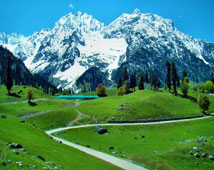
Gulmarg (56Km.)
The valley of Gulmarg, a large meadow about 3-sq-kms in area, stands at 2,730m, 56-km south west of Srinagar. The name means 'Meadow Of Flowers' and in the spring it's just that, a rolling meadow dotted with countless colourful Bluebells, Daisies, Forget Me Not's and Buttercups.
Pahalgam (86Km.)
At an altitude of 2,130m and about 95-km from Srinagar, Pahalgam is probably the most popular hill resort in the Kashmir valley. Since it is rather lower than Gulmarg the nighttime temperatures do not drop so low and it has the further advantage of the beautiful Lidder River running right through the town.
Sonamarg (87Km.)
At a height of 2,740m, Sonamarg is the last major point in the Kashmir valley before the Zoji La pass into Ladakh. At the pass the green, lush Kashmiri landscape abruptly switches to the barren, dry landscape of Ladakh. Sonamarg is thus not only a good base for treks but also a jumping off point for trips into Ladakh.
Amarnath (143Km.)
The Yatra (pilgrimage) on foot to Amarnath Cave, considered one of the holiest naturally occurring shrines of the Hindu faith, has continued annually for little more than a hundred years. Extending up 130 feet, the Amarnath Cave is high and shallow.
Chrar-e-Sharief
Charer-e-Sharif was a Shrine holy to both Muslims and Hindus. The Islamic militants burned it down in 1995 at the behest of Pakistan. Sheikh Nooruddin, after all, was arguably the greatest mystic-saint of Kashmir.
Dachigam National Park (22Km.)
Located very close to Srinagar (22-km), Dachigam National Park with its splendid forests and magnificent scenery is easily accessible. Of all the many sanctuaries in the state, the one at Dachigam is the best known.
Wular Lake (50Km.)
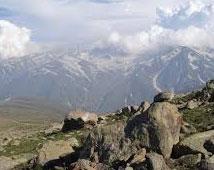
Claimed to be the largest freshwater lake in India, the Wular lake can spread over nearly 200-sq-kms but its actual surface area tends to vary during the year. The Jhelum River flows into the lake, 40-km downstream from Srinagar, and then out again.
Aharbal (51Km.)
This was another popular resting place for the Mughal emperors when they made the long trip north from Delhi to Kashmir. It's in an area famed for its apples and also has an interesting waterfall. It's also the start of the popular trek to the Konsarnag Lake.
By Air
Various airlines fly to Srinagar from New Delhi, Chandigarh, Amritsar, Jammu and there are flights operating from Srinagar to Leh and back. Flights are more frequent during the summer Tourist Season; at that time there will probably be several flights a day between Delhi and Srinagar. Some services are direct, while others operate via Chandigarh, Amritsar or Jammu. Flight time duration from Delhi on the direct flights is about an hour and ten minutes.
By Road
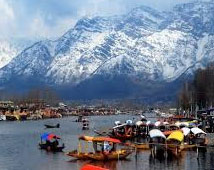
Srinagar is connected by an all weather road to Jammu, which in turn is connected to many parts of North India. One can catch buses from Delhi but people making the trip by road should take up the route via Chandigarh, Amritsar or from the Himachal Pradesh hill stations. Buses leave Jammu early in the morning for the 10 to 12 hour trip to Srinagar in the Kashmir valley. Although there are many buses, still one should book a seat as soon as one arrives in Jammu. The same applies from Srinagar as the day before departure all seats may be sold out. Buses also go from here to Leh and Kargil. The buses all arrive and depart in Srinagar from the Tourist Reception Centre bus compound. From here's it's about a 10 to 15 minute walk to Dal Lake and the houseboat ghats. If one wants to go straight to the houseboat area or to one of the upmarket hotels by the lake ask for the boulevard. Bus bookings are made at the tourist reception centre.
By Rail
Srinagar's railhead is Jammu, which in turn is connects all parts of the country, including Delhi, Kolkata (Calcutta), Pune, Mumbai and Kanyakumari. The distance is about 876-km from Delhi to Srinagar although almost everybody coming up from Delhi, or other Indian cities, by land will come through Jammu from where the buses run daily to Srinagar.